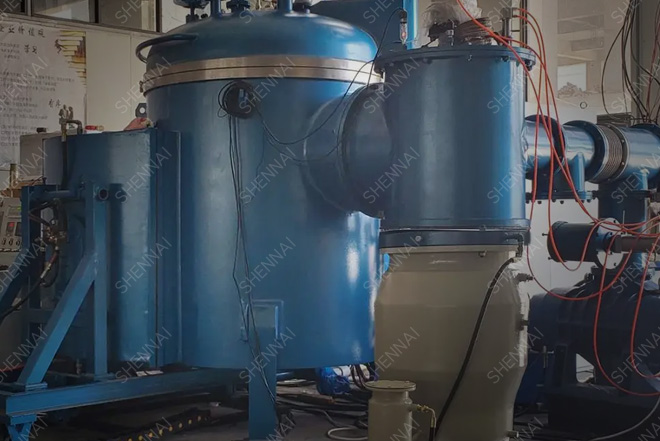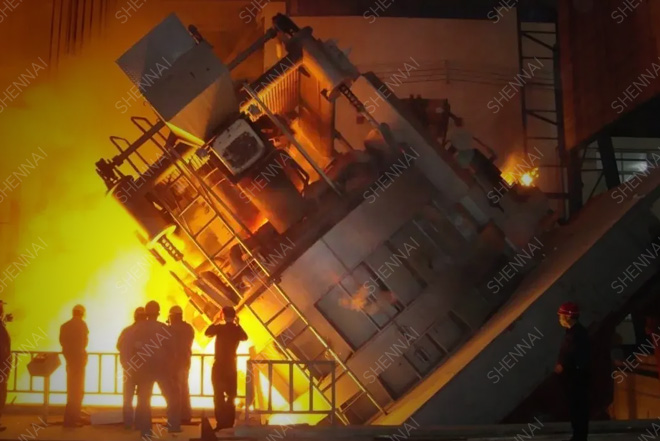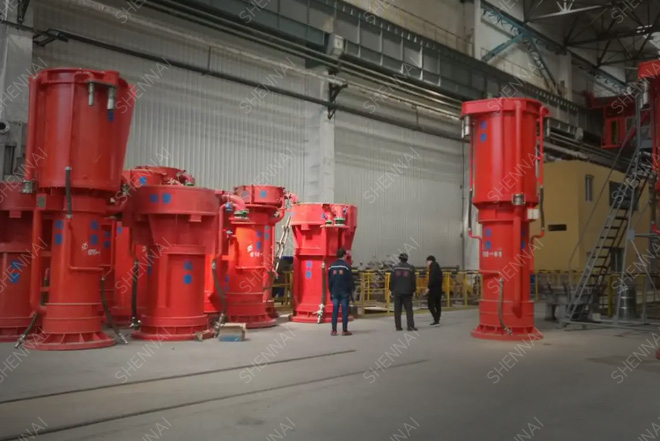- Tel:+8613007564317
- Email:[email protected]
News
At present, the main smelting furnaces are vacuum induction smelting furnace, electric arc smelting furnace and electroslag remelting.
At present, the main smelting furnaces are vacuum induction smelting furnace, electric arc smelting furnace and electroslag remelting.
The vacuum induction melting furnace is mainly used to melt metal materials (such as stainless steel, nickel base alloy, copper, alloy steel, nickel cobalt alloy, rare earth neodymium iron, etc.) under vacuum or protective atmosphere, and also can be used for vacuum refining and precision casting of alloy steel. It is composed of furnace cover, furnace body, furnace bottom, crucible rotation mechanism, vacuum system and medium frequency power control system.

The furnace cover, furnace body and furnace bottom adopt double-layer water-cooling structure to keep the furnace shell temperature not more than 60 ℃. The furnace cover is opened manually. The furnace cover is provided with an observation hole and a baffle. In order to facilitate the addition of alloy elements during the melting process, an alloy feeder is specially arranged on the furnace cover. There is an induction coil in the furnace. By manually turning the handle outside the furnace, the molten liquid in the crucible can be easily poured into the ingot mold. The ingot mold can be designed in the form of water cooling. A temperature measuring device is arranged on the upper part of the crucible.
The vacuum system adopts two-stage pumps, namely K-300 oil diffusion pump and 2x-70 mechanical pump. The mechanical pump is equipped with an electromagnetic air release valve to avoid oil return after power failure. The vacuum unit is equipped with an air release valve and an inflation valve.
The intermediate frequency power supply can be KGPS thyristor or IGBT integrated power supply, all digital circuit, etc. the electrical system is equipped with overcurrent, overvoltage feedback and protection circuit. Eddy current will be generated in the process of electromagnetic induction to melt the metal. This process can be used to refine high purity metals and alloys. It mainly includes vacuum induction furnace smelting, suspension smelting and cold crucible smelting. The nitrogen, hydrogen, oxygen and carbon dissolved in steel and alloy can be easily removed to a much lower level than that smelted under normal pressure during vacuum melting. Meanwhile, impurity elements (copper, zinc, lead, antimony, bismuth, tin and arsenic) with higher vapor pressure than the base metal at melting temperature can be removed by volatilization. The composition of active elements such as aluminum, titanium, boron and zirconium that need to be added to the alloy is easy to control. Therefore, the metal materials melted by vacuum induction can obviously improve the toughness, fatigue strength, corrosion resistance, high temperature creep performance and permeability of magnetic alloys.
Vacuum arc melting

Direct heating arc smelting is an electrothermal metallurgy method that uses electric energy to produce an arc between electrodes or between electrodes and melted materials to smelt metals. The electric arc can be generated by direct current or alternating current. When alternating current is used, there will be instantaneous zero voltage between the two electrodes. In the case of vacuum melting, because the gas density between the two electrodes is very small, it is easy to cause the arc to extinguish, so the DC power supply is generally used for vacuum arc melting.
The electric arc of direct heating arc smelting is generated between the electrode rod and the melted charge. The charge is directly heated by the electric arc, and the electric arc is the heat source for smelting. Direct heating arc smelting mainly includes non vacuum direct heating three-phase arc furnace smelting and direct heating vacuum consumable arc furnace smelting.
(1) Non vacuum direct heating three-phase arc melting method. This is a common method of steelmaking. Steelmaking electric arc furnace is one of the most important non vacuum direct heating three-phase electric arc furnaces. The electric arc furnace commonly referred to refers to this kind of furnace. In order to obtain high alloy steel, it is necessary to add alloy components to the steel, adjust the carbon content and other alloy components in the steel, and remove harmful impurities such as sulfur, phosphorus, oxygen, nitrogen and non-metallic inclusions below the specified range of the product. These smelting tasks are most convenient to complete in the electric arc furnace. The atmosphere in the electric arc furnace can be controlled to be weak oxidizing or even reducing by slagging. The alloy components in the electric arc furnace burn less, and the heating process is easy to adjust. Therefore, although arc melting consumes a lot of electric energy, it is still used in industry to melt various high-grade alloy steels
(2) Direct heating vacuum arc furnace smelting method. It is mainly used to smelt titanium, zirconium, tungsten, molybdenum, tantalum, niobium and other active and high melting point metals as well as their alloys. It is also used to smelt heat-resistant steel, stainless steel, tool steel, bearing steel and other alloy steels. The content of gas and volatile impurities in the metal smelted by the direct heating vacuum consumable arc furnace decreases, the ingot generally does not appear loose in the center, the ingot crystallization is more uniform, and the metal properties are improved. The problem of direct heating vacuum consumable arc furnace smelting is that it is difficult to adjust the composition of metal (alloy). Although the cost of furnace equipment is much lower than that of vacuum induction furnace, it is higher than that of electroslag furnace, and the smelting cost is also much higher. Vacuum consumable arc furnace was applied to industrial production only in 1955. It was first used to smelt titanium, and then used to smelt other high melting point metals, active metals and alloy steels.
Indirect heating arc melting
The arc of indirect heating arc smelting is generated between two graphite electrodes, and the furnace charge is indirectly heated by the arc. This smelting method is mainly used for smelting copper and copper alloys. Indirect heating arc smelting is gradually being replaced by other smelting methods due to its high noise and poor metal quality.
Electroslag remelting furnace is a kind of electric furnace equipment that uses the protection method of insulating air from molten slag to refine some steels or alloys.
Schematic diagram of working principle of electroslag remelting furnace in terms of heating principle, electroslag remelting furnace is a resistance smelting furnace. Electroslag remelting process is that the lower end of electrode is immersed in molten slag. When the AC current passes through the high resistance slag pool, it generates a lot of heat. It melts the electrode end embedded in the molten slag. The molten metal drops produced by melting pass through the slag pool and drop into the metal molten pool. Then they are cooled by the water-cooled crystallizer and condensed into ingots. In this process, the metal droplets are in full contact with the slag with high temperature and high alkalinity, resulting in strong metallurgical chemical reaction, so that the metal is refined. The key technology of electroslag remelting furnace is slag system. In electroslag remelting furnace, the main functions of slag are as follows: heat source, protection, molding and metallurgical chemistry. The chemical composition of slag has a great influence on the quality and technical and economic indexes of electroslag smelting products.
The characteristics of slag are:
(1) With high resistivity, it can generate enough heat in the smelting process to ensure metal melting, heating up and purification;
(2) It has certain alkalinity, so its deoxidation and desulfurization effect is good;
(3) It does not contain unstable oxides, such as MnO, FeO, etc;
(4) It has good fluidity to ensure that the convective heat exchange and liquid physical and chemical reaction are fully carried out at high temperature;
(5) It has a low melting point, generally 150~250 ℃ lower than the melting point of the molten metal, which makes the spindle well formed;
(6) It has a high boiling point so as not to volatilize a large amount at high temperature. Main circuit diagram of double column electroslag furnace. Compared with the single column electroslag furnace, the short network is arranged in parallel, which makes the reactance offset, so the power factor is high.
Compared with other remelting equipment, the main advantages of electroslag remelting furnace are:
(1) There is a strong metallurgical chemical reaction between molten metal and slag, so the effect of phosphorus and sulfur removal is relatively good, and the spindle purity is relatively high;
(2) Simple equipment, high productivity and low investment;
(3) The molten slag can isolate the molten metal from the outside air without external pollution;
(4) Slag and molten metal produce metallurgical chemical reaction, which can smelt high-grade metals and alloys;
(5) The nonmetallic inclusions in the molten metal react with the slag, and all the nonmetallic inclusions are removed by the slag;
(6) Because the spindle is cooled in a water-cooled copper crucible, its cooling speed is very fast, which leads to uniform internal structure of the spindle without segregation.
Electroslag remelting furnace has a wide range of applications. It can not only be used to produce aviation bearing steel, high-temperature alloy, precision alloy and some non-ferrous metals, but also can be used to produce large high-quality alloy steel ingots, large flat ingots or plate ingots, hollow steel ingots, composite plates weighing hundreds of tons, as well as melting and casting rollers, gear blanks, turbine discs, pressure vessels, aircraft landing gear Electroslag casting is a kind of electroslag metallurgical process which can complete metal refining and casting at one time to produce high-quality alloy castings. It uses the resistance heat generated by the current passing through the liquid slag to continuously melt the metal electrode, the molten metal converges into drops, drops into the metal molten pool through the slag layer, and solidifies into castings in the special-shaped water-cooling mold.

The electroslag casting process has the following metallurgical characteristics:
(1) The reaction temperature is about 1900 ℃;
(2) Strong stirring in slag pond;
(3) Forced cooling of water-cooled mold;
(4) Slag pool riser heating and metal melting pool can play the role of feeding;
(5) Electro capillary oscillation, with the periodic change of AC, the steel slag interface has micro vibration, which can strengthen the refining process;
(6) Steel and slag shall be in full contact.
The metallurgical characteristics of electroslag casting determine that this technology has the following advantages:
(1) Pure metal. Electroslag casting is a process to improve the precision of castings. The steel slag is fully contacted. The non-metallic inclusions in the steel are absorbed and melted by the slag, effectively removing harmful elements (s, P, Pb, Sb, Bi, Sn, etc.) and harmful gases (n, h, O) in the steel; General gas content can be reduced to about 0.002%; The total amount of inclusions is 0.004% ~ 0.006%, which shows that the molten metal is quite pure.
(2) The metal structure is dense. As the electroslag casting metal is pure and forced cooling is adopted, the density of electroslag casting metal is increased by 0.33% ~ 1.37% compared with ordinary casting metal.
(3) The composition and structure of steel are uniform.
(4) Crystallization refinement of steel.
(5) The casting surface is smooth. Because the surface of electroslag casting is wrapped with a thin layer of slag coating, the casting surface is smooth and does not need machining.
The metal melting, refining, crystallization, forming and other processes are carried out simultaneously in the special-shaped water-cooled crystallizer (mold). Because the metal materials are effectively refined by a reasonable slag system, a large number of non-metallic inclusions, harmful elements and harmful gases in the metal are removed, so as to obtain high-purity castings. At the same time, due to the rapid cooling and sequential crystallization of the casting in the water-cooled mold, the microstructure of the metal is dense and the composition is uniform, the anisotropy of mechanical and physical properties is eliminated, the macrostructure is improved, the common defects such as hairline, porosity, shrinkage cavity, slag inclusion and segregation in general castings are basically eliminated, and the casting performance is improved. The characteristic of electroslag casting is that it can have forging properties without thermal deformation and heat treatment. This is because the electroslag casting metal has uniform chemical composition, dense structure, no dendrite segregation, banded segregation and other defects, and even a small amount of uniform impurities distributed at the grain boundary have no effect on its structure. It is proved that the inherent "as cast fracture" of electroslag casting steel can be eliminated by adding a uniform annealing treatment to the electroslag casting during heat treatment, so as to give full play to the performance potential of electroslag casting steel. The metal consumable electrode is melted in the conductive slag. It is melted by the resistance heat of the slag. The metal forms a molten pool through the slag in the form of melt drops, and then the liquid metal solidifies in the water-cooled copper crystallizer. Also known as electroslag remelting or electroslag casting.
We will get in touch with you as soon as possible
